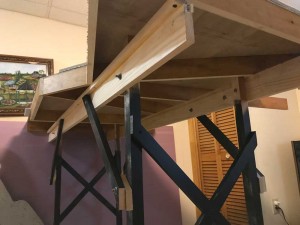The benchwork is complete for the first module on my evolving City Point Terminal layout. Besides being the central focal point of the model railroad, this first module basically will be used to trial model railroad construction and modeling techniques. If the construction and modeling techniques work out well, they will be replicated on future modules, hopefully, without too much change. A model railroad always starts with the foundation, so here is a picture of the underside, as it stands today.

Railroad Bench Bottom
Basic underpinnings of this module follow an L-Girder design, very similar to what I did with my original model railroad. L-Girder design is described in the book “How to Build Model Railroad Benchwork“, by Linn H. Westcott. I have the second edition.
Changes from my original railroad benchwork
Is a much smaller size. This was done to allow the railroad to be built in pieces, moved and reassembled with minimum amount of problems. This module is 6′ 6″ long by a maximum of 4′ wide. Based on what I see today, I think that this is close to the largest size that still could be considered somewhat portable. It will have to be tipped vertically in order to move through normal doorways, but I hope that the finished module will be light enough that this can be done by a couple of people without too much difficulty.
The legs are bolted on to facilitate moving and storage. The bracing on the legs is done differently than what I did before. The end braces are connected where they cross with a dato joint and attached to only one side of the legs, rather than crossing on opposite sides of the leg. This construction should result in more stiffness, with slightly less weight. The other brace going down the side of the L-girder, is shorter than before. This length should provide plenty of stability but allow easier access to the underside of the layout.
The sides of the benchwork where it will eventually mate with adjacent modules are edged with pine boards. The open edges where the module does not mate with adjacent modules will eventually be covered with painted hardboard.
Next blog post will describe the top of the benchwork and roadbed.

